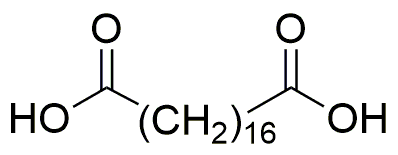Octadecanedioic acid is widely utilized in research focused on:
- Polymer Production: This compound serves as a key ingredient in the synthesis of polyamides and polyesters, which are essential in manufacturing durable plastics and fibers used in textiles and automotive parts.
- Cosmetic Formulations: Its emollient properties make it a valuable addition to skin care products, providing moisture and improving texture, thus enhancing the overall feel of creams and lotions.
- Food Industry: Used as a food additive, it acts as a stabilizer and emulsifier, improving the consistency and shelf-life of various food products.
- Biodegradable Materials: Researchers are exploring its potential in creating eco-friendly materials, contributing to sustainability efforts in packaging and product design.
- Pharmaceutical Applications: It is being investigated for its role in drug delivery systems, where its properties can help in the controlled release of medications, improving therapeutic efficacy.
Informations générales
Propriétés
Sécurité et réglementation
Applications
Octadecanedioic acid is widely utilized in research focused on:
- Polymer Production: This compound serves as a key ingredient in the synthesis of polyamides and polyesters, which are essential in manufacturing durable plastics and fibers used in textiles and automotive parts.
- Cosmetic Formulations: Its emollient properties make it a valuable addition to skin care products, providing moisture and improving texture, thus enhancing the overall feel of creams and lotions.
- Food Industry: Used as a food additive, it acts as a stabilizer and emulsifier, improving the consistency and shelf-life of various food products.
- Biodegradable Materials: Researchers are exploring its potential in creating eco-friendly materials, contributing to sustainability efforts in packaging and product design.
- Pharmaceutical Applications: It is being investigated for its role in drug delivery systems, where its properties can help in the controlled release of medications, improving therapeutic efficacy.
Documents
Fiches de données de sécurité (FDS)
La FDS fournit des informations de sécurité complètes sur la manipulation, le stockage et l’élimination du produit.
Spécifications du produit (PS)
Le PS fournit une description complète des propriétés du produit, notamment sa composition chimique, son état physique, sa pureté et les exigences de stockage. Il détaille également les plages de qualité acceptables et les applications prévues du produit.
Certificats d'analyse (COA)
Recherchez des certificats d'analyse (COA) en saisissant le numéro de lot du produit. Les numéros de lot et de lot se trouvent sur l'étiquette d'un produit, après les mots « Lot » ou « Lot de fabrication ».
Numéro de catalogue
Numéro de lot/série
Certificats d'origine (COO)
Ce certificat d'exploitation confirme le pays dans lequel le produit a été fabriqué, et détaille également les matériaux et composants utilisés et s'il est issu de sources naturelles, synthétiques ou autres sources spécifiques. Ce certificat peut être requis pour les douanes, le commerce et la conformité réglementaire.
Numéro de catalogue
Numéro de lot/série
Fiches de données de sécurité (FDS)
La FDS fournit des informations de sécurité complètes sur la manipulation, le stockage et l’élimination du produit.
DownloadSpécifications du produit (PS)
Le PS fournit une description complète des propriétés du produit, notamment sa composition chimique, son état physique, sa pureté et les exigences de stockage. Il détaille également les plages de qualité acceptables et les applications prévues du produit.
DownloadCertificats d'analyse (COA)
Recherchez des certificats d'analyse (COA) en saisissant le numéro de lot du produit. Les numéros de lot et de lot se trouvent sur l'étiquette d'un produit, après les mots « Lot » ou « Lot de fabrication ».
Numéro de catalogue
Numéro de lot/série
Certificats d'origine (COO)
Ce certificat d'exploitation confirme le pays dans lequel le produit a été fabriqué, et détaille également les matériaux et composants utilisés et s'il est issu de sources naturelles, synthétiques ou autres sources spécifiques. Ce certificat peut être requis pour les douanes, le commerce et la conformité réglementaire.

